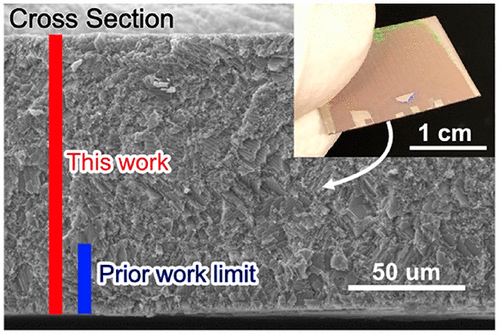Our official English website, www.x-mol.net, welcomes your feedback! (Note: you will need to create a separate account there.)
Thick Free-Standing Metallic Inverse Opals Enabled by New Insights into the Fracture of Drying Particle Films.
Langmuir ( IF 3.9 ) Pub Date : 2020-06-05 , DOI: 10.1021/acs.langmuir.0c00761 Zhimin Jiang 1 , Zakaria Hsain 1 , James H Pikul 1
Langmuir ( IF 3.9 ) Pub Date : 2020-06-05 , DOI: 10.1021/acs.langmuir.0c00761 Zhimin Jiang 1 , Zakaria Hsain 1 , James H Pikul 1
Affiliation

|
Metallic inverse opals are porous materials with enhanced mechanical, chemical, thermal, and photonic properties used to improve the performance of many technologies, such as battery electrodes, photonic devices, and heat exchangers. Cracking in the drying opal templates used to fabricate inverse opals, however, is a major hindrance to the use of these materials for practical and fundamental studies. In this work, we conduct desiccation experiments on polystyrene particle opals self-assembled on indium–tin oxide coated substrates to study their fracture mechanisms, which we describe using an energy-conservation fracture model. The model incorporates film yielding, particle order, and interfacial friction to explain several experimental observations, including thickness-dependent crack spacings, cracking stresses, and order-dependent crack behavior. Guided by this model, we are the first to fabricate 120 μm thick free-standing metallic inverse opals, which are 4 times thicker than previously reported non-free-standing metallic inverse opals. Moreover, by controlling cracks, we achieve a crack-free single-crystal domain up to 1.35 mm2, the largest ever reported in metallic inverse opals. This work improves our understanding of fracture mechanics in drying particle films, provides guidelines to reduce crack formation in opal templates, and enables the fabrication of free-standing large-area single-crystal inverse opals.
中文翻译:

通过对干燥颗粒膜断裂的新见解,实现了厚实的自由金属反蛋白石。
金属反蛋白石是具有增强的机械,化学,热和光子特性的多孔材料,可用于改善许多技术的性能,例如电池电极,光子器件和热交换器。然而,用于制造反蛋白石的干燥蛋白石模板中的开裂是将这些材料用于实际和基础研究的主要障碍。在这项工作中,我们对氧化铟锡涂层基材上自组装的聚苯乙烯颗粒蛋白石进行了干燥实验,以研究其断裂机理,并使用节能断裂模型对其进行了描述。该模型结合了薄膜屈服,颗粒有序和界面摩擦,解释了一些实验观察结果,包括与厚度有关的裂纹间距,裂纹应力和与次序有关的裂纹行为。在此模型的指导下,我们是第一个制造120μm厚的独立式金属反蛋白石的人,它的厚度是以前报道的非独立式金属反蛋白石的4倍。此外,通过控制裂纹,我们实现了高达1.35 mm的无裂纹单晶畴2,有史以来最大的金属反蛋白石报道。这项工作提高了我们对干燥颗粒膜中断裂力学的理解,为减少蛋白石模板中的裂纹形成提供了指导,并使得能够制造独立的大面积单晶反蛋白石。
更新日期:2020-07-07
中文翻译:

通过对干燥颗粒膜断裂的新见解,实现了厚实的自由金属反蛋白石。
金属反蛋白石是具有增强的机械,化学,热和光子特性的多孔材料,可用于改善许多技术的性能,例如电池电极,光子器件和热交换器。然而,用于制造反蛋白石的干燥蛋白石模板中的开裂是将这些材料用于实际和基础研究的主要障碍。在这项工作中,我们对氧化铟锡涂层基材上自组装的聚苯乙烯颗粒蛋白石进行了干燥实验,以研究其断裂机理,并使用节能断裂模型对其进行了描述。该模型结合了薄膜屈服,颗粒有序和界面摩擦,解释了一些实验观察结果,包括与厚度有关的裂纹间距,裂纹应力和与次序有关的裂纹行为。在此模型的指导下,我们是第一个制造120μm厚的独立式金属反蛋白石的人,它的厚度是以前报道的非独立式金属反蛋白石的4倍。此外,通过控制裂纹,我们实现了高达1.35 mm的无裂纹单晶畴2,有史以来最大的金属反蛋白石报道。这项工作提高了我们对干燥颗粒膜中断裂力学的理解,为减少蛋白石模板中的裂纹形成提供了指导,并使得能够制造独立的大面积单晶反蛋白石。



























 京公网安备 11010802027423号
京公网安备 11010802027423号